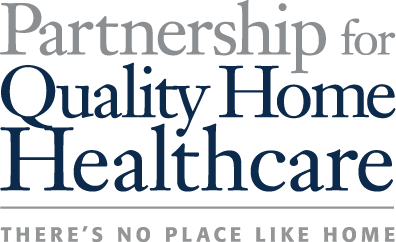June 13, 2022
Specialized Clinical Programs – The Future of Home Health?
Representing some of the nation’s leading home healthcare providers, the Partnership’s members are dedicated to developing innovative reforms to improve the program integrity, quality, and efficiency of the Medicare home healthcare program for our nation’s seniors.
An example of this innovation can be seen in LHC Group’s new clinical program, Choose Control. We spoke with Kyle Lavergne, director of clinical programs, to learn more about this program:
How prevalent is diabetes among your Medicare home health patients?
We typically find that around 10 percent of our patients have a primary or secondary diagnosis of type 2 diabetes. However, the prevalence of diabetes as a comorbid condition is around 20 percent on any given day.
What is Choose Control?

Choose Control is LHC Group’s clinical program designed specifically to help type 2 diabetics really understand and manage their disease, with the ultimate goal of learning how to self-manage their disease and avoiding hospital readmission. We want patients to effectively manage their disease at home and live well despite their condition.
People so often get diagnosed and then try to figure it out on their own – they take their meds, but they don’t always understand how diabetes really affects them. And with Medicare-aged patients, we’re talking about patients who take probably five to six different meds for multiple chronic conditions – it’s a lot to keep up with.
And we know that providers don’t get as much time as they would like to educate the patient. Choose Control acts as an extension of their care in the clinic – or an extension of that outpatient diabetes education class – to improve those outcomes.
What are the core components of the Choose Control program?
That one-on-one patient education is the heart of Choose Control. Patients on the program spend their entire home health episode learning about diabetes and how it affects the way their body works and their overall health.
Choose Control has specific clinical pathways that align with our patient education, making it easier for our nurses to have a clear idea of exactly what to teach the patient and help them hit their goals. And our clinicians take several hours of additional continuing education courses before being able to provide Choose Control. That way we’re up to date on the newest best practices when it comes to diabetes care.
What are the benefits of this program for home health patients and providers?
For patients, it’s gaining a deep understanding of how to manage their disease. And of course, this training transfers, to some extent, to managing other conditions as well. You only get a few minutes with your doctor – and this information can be confusing, especially if you’re managing multiple chronic conditions.
With Choose Control, you have a nurse coming to your house to explain things like how blood sugar works, how diet, exercise, and smoking can affect diabetes, how to take each medication, and even how to monitor your stress and emotional health – because we know those things affect our total health.
For providers, our goal is to produce better outcomes. Our pilot study saw readmission rates drop from 16.7 percent to 10.7 percent, which means Choose Control kept at-risk patients out of the hospital. And with value-based care continuing as a big focus, it’s going to be more and more important to demonstrate outcomes that lower cost. That’s how you demonstrate the value of the service for providers.
Have you seen further results since launching Choose Control?
Yes, in a couple of areas. Obviously, there are the clinical outcomes, which by and large are right in line with our pilot study. But that’s a moving target. For example, what works for one market to reduce rehospitalizations may not work in another. So, our focus is on learning how to make adjustments to the system to achieve desired results within a given community. Some ACH rates are higher than we’d like at the moment. But we know that identifying those areas is the first step to correcting the problem.
Additionally, we’ve seen that both clinical teams and business development teams appreciate the standardization. It makes decision making simpler and provides a foundation that all agencies share in common regardless of location or personnel. We’re all working from the same playbook.
How have patients and their families responded to the program?
Extremely positively. A patient in Oklahoma comes to mind. He was struggling, complaining to his PCP that he wasn’t feeling well and falling even though he was taking his meds. So, our agency got the referral to go out and see what was happening.
At our evaluation, the nurse asked him to show her how he took his insulin. She quickly realized that he was injecting himself with 100 units instead of 10 units – he was overdosing because he didn’t fully understand how to take his meds.
Thankfully, the nurse was able to intervene. We got him on Choose Control and helped the patient correct a lot of his unintended bad habits. The patient’s PCP credited the program with saving his life, and we avoided another hospitalization. I don’t think you can ask for a better outcome than that.
How do you see Choose Control fitting into the bigger picture of quality home healthcare?
If we’re going to get serious about value-based care, home health must shift into specialized care and focus on value relative to the disease or problem we’re treating. Generalization isn’t what it used to be. The problems we’re solving in the home are more complicated than they’ve ever been, and we need solutions that address the most immediate problems very specifically and very accurately. Choose Control is an example of just that.
Historically, home health has operated as a generalized practice – we all provided essentially the same set of services to all of our patients, regardless of their diagnosis. But that can lead to mediocre outcomes as patient complexity increases. We know that a diabetic patient is different than a heart failure patient. So why would we treat them the same?
By narrowing down that focus and providing specific pathways and protocols that are both standardized and adhere to the most current disease-specific management standards, it becomes much easier to track performance metrics like readmission rates, ED utilization, and documentation accuracy.
And being able to track those outcomes in near real-time allows us to provide better care that will always be more valuable to patients and providers.
Specialty programs like Choose Control are the vital first step in helping modernize patient care where patients want it most – in their home.
